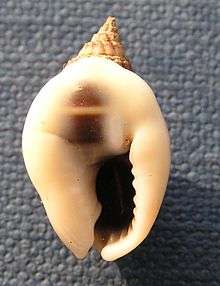Nassarius pullus
| Nassarius pullus | |
|---|---|
 | |
| Nassarius pullus | |
| Scientific classification | |
| Kingdom: | Animalia |
| Phylum: | Mollusca |
| Class: | Gastropoda |
| (unranked): | clade Caenogastropoda clade Hypsogastropoda clade Neogastropoda |
| Superfamily: | Buccinoidea |
| Family: | Nassariidae |
| Subfamily: | Nassariinae |
| Genus: | Nassarius |
| Species: | N. pullus |
| Binomial name | |
| Nassarius pullus Linnaeus, 1758 | |
| Synonyms[1] | |
|
list of synonyms
| |
Nassarius pullus, common names : black nassa; olive dog whelk; ribbed dog whelk, is a species of sea snail, a marine gastropod mollusk in the family Nassariidae, the Nassa mud snails or dog whelks.[1]
Description
The length of the shell varies between 10 mm and 25 mm
The shell is ovate and ventricose. The pointed spire is composed of six or seven whorls. These are slightly angular at their upper part, loaded with very convex longitudinal folds near the suture. These folds are less prominent, and more flattened upon the outer lip of the body whorl. It is intersected by numerous transverse striae. The upper extremity of the fold is sometimes separated by a stria which divides them superficially. The white aperture is ovate, terminated above by an emargination of the outer lip, and by a transverse ridge of the inner lip. The outer lip is thin, slightly denticulated at the base, furnished with numerous striae; internally. The columella is arcuated, covered by the inner lip, which conceals, by its expansion, a part of the body of the shell, and forms a large, white, and polished callosity. The ground color of this shell is whitish, ash or bluish, sometimes without spots or bands, at other times with two or three deeper bands which surround the whorls. [2]
Distribution
This species occurs in the Central and East Indian Ocean off Mauritius, Madagascar and Tanzania ; off East India, Sri Lanka, Thailand, the Philippines, China, and in the Western Pacific Ocean off Papua New Guinea, New Caledonia, the New Hebrides, the Solomon Islands and Australia (Queensland).

References
- 1 2 Nassarius pullus Linnaeus. Retrieved through: World Register of Marine Species on 28 October 2012.
- ↑ Kiener (1840). General species and iconography of recent shells : comprising the Massena Museum, the collection of Lamarck, the collection of the Museum of Natural History, and the recent discoveries of travellers; Boston :W.D. Ticknor,1837 (described as Buccinum pullus)
- Linnaeus, C. 1758. Systemae naturae per regna tria naturae, secundum classes, ordines, genera, species, cum characteribus, differetiis, synonymis, locis.v. Holmiae : Laurentii Salvii 824 pp.
- Bruguière, J.G. 1789. Buccinum. Encyclopédie Méthodique ou par de matieres. Historie Naturelle des Vers et Mollusques 1: 236-285
- Adams, A. 1852. Catalogue of the species of Nassa, a genus of Gasteropodous Mollusca, belonging to the family Buccinidae, in the Collection of Hugh Cuming, Esq., with the description of some new species. Proceedings of the Zoological Society of London 1851(19): 94-112
- Dautzenberg, Ph. (1929). Mollusques testacés marins de Madagascar. Faune des Colonies Francaises, Tome III
- Satyamurti, S.T. 1952. Mollusca of Krusadai Is. I. Amphineura and Gastropoda. Bulletin of the Madras Government Museum, Natural History ns 1(no. 2, pt 6): 267 pp., 34 pls
- Spry, J.F. (1961). The sea shells of Dar es Salaam: Gastropods. Tanganyika Notes and Records 56
- Cernohorsky W.O. (1981). Revision of the Australian and New Zealand Tertiary and Recent species of the family Nassariidae (Mollusca: Gastropoda). Records of the Auckland Institute and Museum 18:137-192.
- Cernohorsky W. O. (1984). Systematics of the family Nassariidae (Mollusca: Gastropoda). Bulletin of the Auckland Institute and Museum 14: 1-356.
- Wilson, B. 1994. Australian Marine Shells. Prosobranch Gastropods. Kallaroo, WA : Odyssey Publishing Vol. 2 370 pp.
External links
| Wikimedia Commons has media related to Nassarius pullus. |